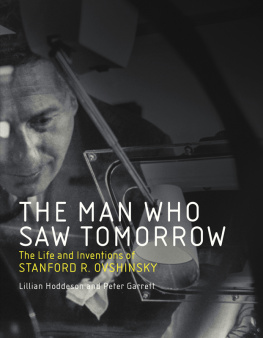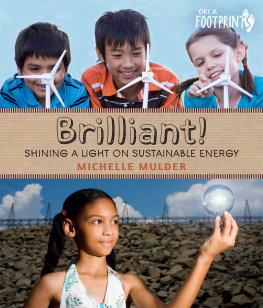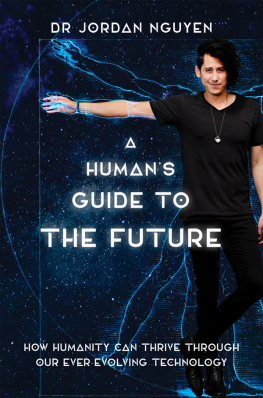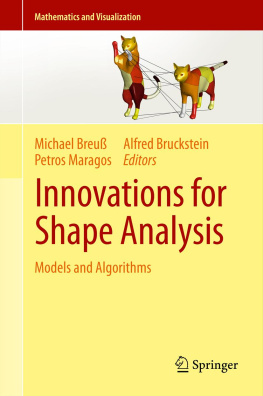Hoddeson Lillian - The Man Who Saw Tomorrow
Here you can read online Hoddeson Lillian - The Man Who Saw Tomorrow full text of the book (entire story) in english for free. Download pdf and epub, get meaning, cover and reviews about this ebook. year: 2018, publisher: MIT Press, genre: Home and family. Description of the work, (preface) as well as reviews are available. Best literature library LitArk.com created for fans of good reading and offers a wide selection of genres:
Romance novel
Science fiction
Adventure
Detective
Science
History
Home and family
Prose
Art
Politics
Computer
Non-fiction
Religion
Business
Children
Humor
Choose a favorite category and find really read worthwhile books. Enjoy immersion in the world of imagination, feel the emotions of the characters or learn something new for yourself, make an fascinating discovery.
- Book:The Man Who Saw Tomorrow
- Author:
- Publisher:MIT Press
- Genre:
- Year:2018
- Rating:3 / 5
- Favourites:Add to favourites
- Your mark:
- 60
- 1
- 2
- 3
- 4
- 5
The Man Who Saw Tomorrow: summary, description and annotation
We offer to read an annotation, description, summary or preface (depends on what the author of the book "The Man Who Saw Tomorrow" wrote himself). If you haven't found the necessary information about the book — write in the comments, we will try to find it.
The Man Who Saw Tomorrow — read online for free the complete book (whole text) full work
Below is the text of the book, divided by pages. System saving the place of the last page read, allows you to conveniently read the book "The Man Who Saw Tomorrow" online for free, without having to search again every time where you left off. Put a bookmark, and you can go to the page where you finished reading at any time.
Font size:
Interval:
Bookmark:
Lillian Hoddeson and Peter Garrett
The MIT Press
Cambridge, Massachusetts
London, England
2018 Massachusetts Institute of Technology
All rights reserved. No part of this book may be reproduced in any form by any electronic or mechanical means (including photocopying, recording, or information storage and retrieval) without permission in writing from the publisher.
This book was set in ITC Stone Sans Std and ITC Stone Serif Std by Toppan Best-set Premedia Limited. Printed and bound in the United States of America.
Library of Congress Cataloging-in-Publication Data
Names: Hoddeson, Lillian, author. | Garrett, Peter K., author.
Title: The man who saw tomorrow : the life and inventions of Stanford R. Ovshinsky / Lillian Hoddeson and Peter Garrett.
Description: Cambridge, MA : The MIT Press, [2018] | Includes bibliographical references and index.
Identifiers: LCCN 2017032336 | ISBN 9780262037532 (hardcover : alk. paper)
eISBN 9780262345026
Subjects: LCSH: Ovshinsky, Stanford R. | Electrical engineers--United States--Biography. | Inventors--United States--Biography.
Classification: LCC TK140.O97 H63 2018 | DDC 621.3092 [B] --dc23 LC record available at https://lccn.loc.gov/2017032336
ePub Version 1.0
It took me a long time working as a historian of science to come to the subject of this book, though in retrospect I realize that I might have come to it much sooner. In the mid-1980s, I was surprised by a postcard from the eminent physicist Sir Nevill Francis Mott, who had shared the 1977 Nobel Prize for research on magnetic and disordered systems. Having recently heard me speak on a topic in the history of solid-state physics at a small meeting he had organized in London, Mott suggested that I consider writing about the new area of amorphous and disordered solids.
I simply did not know what to do with this suggestion. Amorphous and disordered materialsmaterials lacking the rigidly ordered structure of crystalswere already receiving increasing attention from physicists but not from historians. I did not have the background I thought necessary to open up this new historical research area on my own, and in any case I was already over my head with co-editing a massive history of the entire field of solid-state physics. Had I taken Motts suggestion I would have encountered the work of Stanford R. Ovshinsky two decades earlier than I did, but any history I might have written then would have been more narrowly focused and less engaging than this biography.
When I later came to write about Ovshinsky, it was at the suggestion of a different senior physicist. The adventure started in December 2004, when Peter Fritzsche, my colleague in the History Department at the University of Illinois, gave a copy of my recently published biography of the physicist John Bardeen to his father as a Christmas present. Hellmut Fritzsche, a condensed matter physicist who had been working with Ovshinsky for decades (as, indeed, had Mott), got in touch with me a few weeks later. He said he had enjoyed the Bardeen biography but had an even better subject to suggest for my next book. I had never heard of Ovshinsky, nor (again) did I have time to spare from other commitments.
But Fritzsche did arouse my curiosity: he told me that Ovshinsky, whose formal education ended with high school, had made crucial discoveries leading to the growth of a new branch of materials science, and that he was using his new materials to create alternative energy technologies aimed at reducing global warming. Fritzsches anecdotessuch as ones about how travelling with Ovshinsky could get complicated because, true to his union roots, he would never cross a picket lineprovided intriguing glimpses into Ovshinskys personality. This is a fascinating story waiting to be told, Fritzsche wrote to me a few days later. Eventually, after almost a year, I gave in to my curiosity and visited Ovshinskys laboratory, Energy Conversion Devices (ECD), in a northern suburb of Detroit.
On that visit I met Stanford Ovshinsky as well as Iris Ovshinsky, his wife and partner of some fifty years, who was constantly at his side. Both were intensely serious about promoting clean energy, and they proudly showed me examples of ECDs recent achievements. I was impressed by the companys huge 25-megawatt solar panel machine (Iris whispered to me, Youre supposed to say wow!). And it was a thrill to drive ECDs converted Toyota Prius, which ran on hydrogen and was certainly the quietest and cleanest car I had ever handled. Hearing Ovshinsky describe his vision of an energy economy based on solar and hydrogen power, I felt as if that future had already arrived. I also realized that I was in the presence of a genius quite different from any of the outstanding scientists I had known or written about previously. For one thing, his aim was not simply explaining the world. He hoped to change it.
I was soon convinced that Ovshinskys life was worth examining. His many inventions (he had been awarded over four hundred patents) and the broader applications of his materials in the areas of energy and information made him a significant figure in the history of technology. Working long after the era of great independent inventors like Edison and Bell, he showed what an exceptional individual could still accomplish in a time when so much innovation and discovery came from industrial and university laboratories. My interest in Ovshinsky also involved more general questions about scientific and technological creativity. Writing about Bardeen had led me to approach scientific thinking from the perspective of cognitive psychology, and I was just then examining the scientific use of analogy, which seemed to play an even larger role in Ovshinskys work than in Bardeens. I became eager to understand how Ovshinskys extraordinary mind worked and how his life experience had contributed to his inventions.
I still hesitated to take on the task of writing about Ovshinsky because of my other commitments. At the same time, knowing all too well how impermanent living sources are, I didnt want to lose the opportunity to record Ovshinsky telling his own story. I decided to conduct a few in-depth oral history interviews and turn them over to one of my former collaborators, who had expressed interest in using the materials to write a book. The interviewing began in January 2006.
Half a year later, my relationship to Ovshinsky suddenly shifted. My presence at Iriss tragic death (described in chapter 11) involved me more closely in his life, and I decided to write his story myself.
That was ten years ago. I believed then that the work would not take very long, because there was plenty of documentation accessible in the files at ECD, and more in the Ovshinsky home. Most of the characters were alive and seemed eager to help. Soon I was visiting ECD every few months, sifting through papers, conducting interviews with Ovshinsky and his colleagues, drafting preliminary chapters, and occasionally sharing my thoughts about his work with colleagues in seminars, conference papers, or colloquia.
But my expectations turned out to be much too optimistic. The largest cache of documents, those at ECD, would be destroyed by the time I needed to use them (for reasons explained in chapters 11 and 12). Moreover, Ovshinsky turned out to be the most difficult interview subject I had encountered in thirty-some years of conducting oral history interviews. His memory was still vivid despite his age (he was already over eighty). But not only was his memory highly selective (as all human memory is), his stories had been repeated so many times that they had hardened into a mask of the image he wanted to project. My efforts to penetrate this mask and get a more complex account typically just made him angry.
Font size:
Interval:
Bookmark:
Similar books «The Man Who Saw Tomorrow»
Look at similar books to The Man Who Saw Tomorrow. We have selected literature similar in name and meaning in the hope of providing readers with more options to find new, interesting, not yet read works.
Discussion, reviews of the book The Man Who Saw Tomorrow and just readers' own opinions. Leave your comments, write what you think about the work, its meaning or the main characters. Specify what exactly you liked and what you didn't like, and why you think so.







